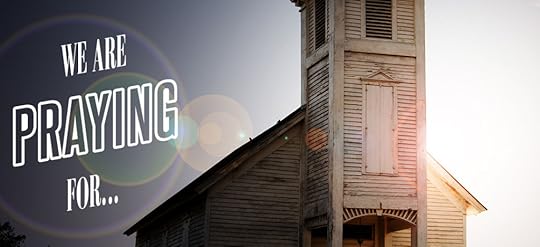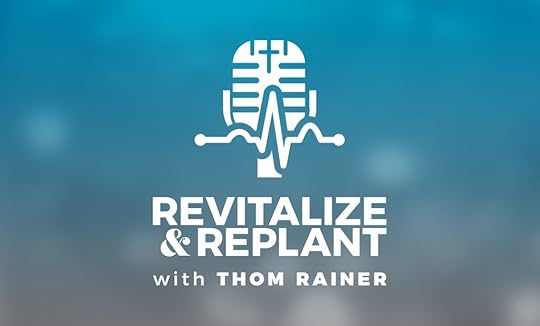Thom S. Rainer's Blog, page 98
January 15, 2020
Why Christian Leaders Struggle with “Dark Nights of the Soul”

By Chuck Lawless
If you read church history at all, you’ll learn that men as faithful to God as Martin Luther and Charles Spurgeon struggled with bouts of at least heaviness, if not depression. I’m convinced more church leaders than we know face these battles. Here are some reasons we do, followed by a simple suggestion when we struggle:
Our calling is a calling of God. We’re blessed to have that calling, but we still answer to the Creator of eternity. That’s a weighty reality that sometimes gets really heavy.
We work with life and death. In fact, we work in the light of eternity, reminding people of life and death matters. Just that fact can pound on our shoulders.
We live with our own sin. No church leader I know wants to be hypocritical in front of church members, but all of us know our own sin issues. Our desire to be leaders of integrity increases the burden of our own sin.
Sometimes, few people respond to our leading. Jesus warned us that many would not choose the right path, but His warning doesn’t lessen the pain when few people respond positively to our ministry.
We carry the weight of the burdens of others. Yes, we can pray and turn them over to God – but our heart still hurts when others hurt.
Many of us have few real friends. Sometimes we’ve made that choice (wrongly, in my opinion), but it’s still lonely when you bear ministry alone.
We don’t always use spiritual disciplines well. For some, disciplines are sporadic at best. For others, we turn to them only as a Band-Aid to try to legalistically fix our issues. Neither takes us closer to the God who wants to heal us.
We tend to be perfectionists. I don’t know many pastors who like to mess up. We want to do well, to please others as we serve God. Any failure brings pain.
We haven’t learned the power of 2 Corinthians 12:10. We preach about strength in weakness, but we haven’t learned how to live it.
We struggle with the dark night, and then beat ourselves up for being depressed. “No strong believer should feel this way,” we think – and the cycle continues.
If you’re struggling with this kind of anguish, I plead with you to talk with a brother or sister in Christ. You’re not the only one facing this battle, but you won’t likely win it if you battle alone. For all of us – let’s say a prayer today for our church leaders.
January 14, 2020
Four Signs of Bad Church Bylaws

Podcast Episode #606
SUBSCRIBE:
iTunes • RSS • Stitcher • TuneIn Radio • Google Play • iHeart Radio • Spotify
While the thought of church bylaws may not interest you at first, what you don’t know about the complicated nature of church governing may very well lead to trouble. In today’s episode, Thom and Sam unpack why church bylaws exist and four signs of bad church bylaws.
Highlights:
When the bylaws are too complex and wieldy
When the bylaws are largely reactionary
When the bylaws are more “stop signs” than guides
When the bylaws are dated, particularly with important legal changes
Other highlights:
If your church bylaws are exciting then they are likely problematic.
Church bylaws are meant to reflect your current practices, not dictate what you are supposed to do.
Church bylaws should be proactive, not reactive.
As a leader, you must be an expert on your church bylaws.
Church bylaws should be exhaustively reviewed every three years.
Resources mentioned in today’s podcast:
Church Consulting University Webinar
Josh Bryant, Church General Counsel
Church Answers Consulting
Church of the Year Nominations
Episode Sponsors
 Vanderbloemen has been serving churches for nine years, but did you know that Vanderbloemen also serves Christian schools, nonprofits, and Christian businesses? So if you’re listening, and you know a Christian school, nonprofit, or values-based business that is hiring, contact our friends at Vanderbloemen for your staffing needs.
Vanderbloemen has been serving churches for nine years, but did you know that Vanderbloemen also serves Christian schools, nonprofits, and Christian businesses? So if you’re listening, and you know a Christian school, nonprofit, or values-based business that is hiring, contact our friends at Vanderbloemen for your staffing needs.
For more information, visit Vanderbloemen.com.
 The mission at Southeastern Baptist Theological Seminary is to glorify the Lord Jesus Christ by equipping students to serve the church and fulfill the Great Commission. The school offers more than 40 different degree programs, including the new Master of Arts in Church Revitalization in partnership with Church Answers and the Revitalization Network. This 37-hour degree is designed to help students move established churches from flatlining to flourishing.
The mission at Southeastern Baptist Theological Seminary is to glorify the Lord Jesus Christ by equipping students to serve the church and fulfill the Great Commission. The school offers more than 40 different degree programs, including the new Master of Arts in Church Revitalization in partnership with Church Answers and the Revitalization Network. This 37-hour degree is designed to help students move established churches from flatlining to flourishing.
Learn about this program and more by visiting sebts.edu. Where are you going? Southeastern will help you get there.
Feedback
If you have a question you would like answered on the show, fill out the form on the podcast page here at ThomRainer.com. If we use your question, you’ll receive a free copy of Scrappy Church.
January 13, 2020
Don’t Let the Angry Ten Percent Control the Direction of Your Church

By Thom S. Rainer
In any organization of size, there are likely angry people.
They are unhappy with the organization. They don’t like change. They don’t like the leader.
But here’s the catch: In most organizations, they are a distinct minority. I use the quantifier of ten percent more anecdotally than not, but I would conjecture most organizations, including churches, would have a number close to that.
In churches, I see pastors, again and again, yield to the pressures and criticisms of the ten percent. I get it. I’ve been there and done that. May I suggest some perspectives on this issue? Perspectives are not solutions, but they can help us persevere when the ten percent get really loud.
Ten percent can seem like a lot of people. Indeed, if your church has 200 active members, 20 loud critics can seem really loud. Brad Waggoner calls it “the power of negativity.” He says the negative person has a tenfold voice in the organization compared to the neutral and positive people.
Realize that the ten percent will take advantage of any forum you give them. They love to speak up in business meetings. They love to be the big voice in listening sessions and surveys. In fact, listening sessions can make the rest of the organization demoralized as the more positive members think the negative people are the norm.
The ten percent want you to think there are more of them. They will use phrases like, “Everyone says . . .” or “People are saying . . .” They not only can be negative; they can be downright deceitful.
While you want to have open communications, the ten percent will often dominate the rest of the voices in the church. Such is the reason you need to be careful about giving them the platforms and opportunities to spread their negativity.
The ten percent love social media. They are often the most vicious when they are hiding behind a keyboard. If you wonder why you are getting sick of social media, it’s because the ten percent live there. They love the megaphone that makes their voices seem louder than they really are.
The ten percent often are on church rotations. If they can’t get their way, they will move to another church where they can spread their negativity. Be cautious of people who want to transfer to your church if they have nothing but negative things to say about their current church.
The ten percent often lead church splits. They will be happy at their new place . . . until they don’t get their way completely. They will then be ready to spread their negativity at the new congregation. Such is the reason so few church splits do well.
This overview is just one of many perspectives rather than solutions. If you feel like most people are against you in your church, you are likely wrong. It’s probably the ten percent. But they do have the loudest voices in your congregation.
January 12, 2020
Pray for Scottsdale Christian Church

Location: Scottsdale, Arizona
Pastor: Thom Malone
Weekly Worship: Sundays at 9:30 AM, Mountain
Fast Facts: Scottsdale Christian Church has been serving south Scottsdale, Arizona for 62 years. Many lives have been changed because of the presence of the church in the community. The church is mainly an older congregation due to the neighborhood they are located in.
The church has adopted a low income senior apartment complex in their neighborhood, Hacienda De Los Arcos, and they will being doing many outreach projects throughout 2020. Their first project is a service “Handyman” Day on January 18th where they will be doing odd jobs that the residents are no longer able to for themselves – flipping their mattresses, cleaning high shelves, rearranging furniture, changing light bulbs, etc. Since the residents are low income, the church will also be providing other services and help through out the year as needs arise.
Pastor Malone spends one day a month on campus visiting the residents of Hacienda De Los Arcos and offering them communion. The church provides transportation to church services each week, and will be establishing a weekly Bible study on the property in the next few months. Please pray for Scottsdale Christian and Pastor Malone as they minister to and share the love of Christ with the residents.
Also, please pray for God to provide a new space for Scottsdale Christian to meet. The church sold their building due to its poor condition and moved into a rental space. Unfortunately, the owners of the building have decided to sell the property for redevelopment, and the church will have to relocate. They are having issues finding a new space to house their church with their limited funds. Please pray that God would provide Scottsdale Christian with a new space to replant and grow their church and be a vital part of their community.
Website: ScottsdaleCC.Com
“Pray for . . .” is the Sunday blog series at ThomRainer.com. We encourage you to pray for these churches noted every Sunday. Please feel free to comment that you are praying as well.
If you would like to have your church featured in the “Pray for…” series, fill out this information form..
January 10, 2020
Four Occasions When Your Church May Need a Transitional Pastor

Podcast Episode #605
SUBSCRIBE:
iTunes • RSS • Stitcher • TuneIn Radio • Google Play • iHeart Radio • Spotify
Has a long-term pastor in your church retired? Is your church in crisis or conflict? Has the community surrounding you changed significantly? Sometimes churches are in need of a transitional pastor. Thom and Sam discuss what this specific role looks like, how it is different from a traditional interim pastor, and four occasions when your church may need a transitional pastor.
Highlights:
When a long-term pastor retires
When the church is in crisis or conflict
When the community has changed significantly
When the church has been inwardly focused for years
Other highlights:
If your church is in crisis or conflict you may need a transitional pastor.
A transitional pastor who can be more invested in the health and future of the church is essential following a crisis.
A transitional pastor may be able to help your church understand what it looks like to resemble the beauty and diversity of your community.
The movement from an inward focus to an outward focus is one of the greatest disruptions in the church.
Resources mentioned in today’s podcast:
Church Answers Consulting
Revitalize Network
The Disruption Mindset: Why Some Organizations Transform While Others Fail by Charlene Li
Church Consultation University Webinar
Revitalize2020.com
Episode Sponsors
 Vanderbloemen has been serving churches for nine years, but did you know that Vanderbloemen also serves Christian schools, nonprofits, and Christian businesses? So if you’re listening, and you know a Christian school, nonprofit, or values-based business that is hiring, contact our friends at Vanderbloemen for your staffing needs.
Vanderbloemen has been serving churches for nine years, but did you know that Vanderbloemen also serves Christian schools, nonprofits, and Christian businesses? So if you’re listening, and you know a Christian school, nonprofit, or values-based business that is hiring, contact our friends at Vanderbloemen for your staffing needs.
For more information, visit Vanderbloemen.com.
 The mission at Southeastern Baptist Theological Seminary is to glorify the Lord Jesus Christ by equipping students to serve the church and fulfill the Great Commission. The school offers more than 40 different degree programs, including the new Master of Arts in Church Revitalization in partnership with Church Answers and the Revitalization Network. This 37-hour degree is designed to help students move established churches from flatlining to flourishing.
The mission at Southeastern Baptist Theological Seminary is to glorify the Lord Jesus Christ by equipping students to serve the church and fulfill the Great Commission. The school offers more than 40 different degree programs, including the new Master of Arts in Church Revitalization in partnership with Church Answers and the Revitalization Network. This 37-hour degree is designed to help students move established churches from flatlining to flourishing.
Learn about this program and more by visiting sebts.edu. Where are you going? Southeastern will help you get there.
Feedback
If you have a question you would like answered on the show, fill out the form on the podcast page here at ThomRainer.com. If we use your question, you’ll receive a free copy of Scrappy Church.
January 9, 2020
Why Churches Must Work Together in Revitalization – Revitalize and Replant #127

SUBSCRIBE TODAY:
iTunes • RSS • Stitcher • TuneIn Radio • Google Play • Spotify
Revitalization is not just a small church issue. Between 65%-90% of churches in North America are in need of revitalization. The work of church revitalization must be a group effort. Thom and Kevin share their perspectives regarding this absolute need for cooperation.
Highlights:
Revitalization is needed at most churches. We cannot do this task alone.
Leaders need to know they are not alone.
Leaders need to celebrate together.
Leaders need to learn and find resources together.
Resources mentioned in today’s podcast:
Church Answers
Revitalize 2020
Church of the Year Nominations
Anatomy of a Revived Church – Thom S. Rainer
NAMB Resources
Revitalize Bundle

Revitalize & Replant is sponsored by the North American Mission Board and ChurchReplanters.com. More than 10% of churches in North America are at risk of closing and the North American Mission Board is committed to reversing this trend by decreasing the death rate of existing churches while simultaneously increasing the birth rate of new churches. To learn more about what it means to become a replanting pastor or to explore resources for replanting and revitalization in your own church, visit ChurchReplanters.com.
Submit Your Question:
Do you have a question about church revitalization or replanting for us to use on the podcast? Visit the podcast page to submit your question. If we use it on the show, you’ll get a copy of Autopsy of a Deceased Church and Reclaiming Glory.
January 8, 2020
Five Advantages of a Flexible Church Staff

By Sam Rainer
Few established churches turn on a dime. Some don’t turn at all. One of the contributing causes is inflexibility. Leading an organization full of inflexible people is like trying to run a marathon without bending your knees. It’s anything but smooth.
Every church has some inflexible people. Part of being a pastor is helping people get unstuck and unfrozen. And most churches also have plenty of people ready to move. Part of being a pastor is encouraging them to lead by example. Working this flexibility into the congregation takes patience, love, and a lot of time.
But on a day-to-day basis, a flexible staff is a freeing gift for the senior pastor or key church leader. Being a flexible staff person does not mean being a doormat. Nor does flexibility imply apathy. It’s also not a “whatever goes” mentality. Rather, flexibility is a willingness to give up preferences for the greater good. It’s a submissive spirit to what is best, even if it means giving up something valuable. When the church staff is flexible, a senior pastor gains several leadership advantages. I’ll share five of these advantages.
More care. When a staff person is flexible, it shows he or she cares. Servant leaders tend to be more flexible. Flexibility demonstrates selflessness. In fact, much of what drives rigidity is selfishness.
Less conflict. A flexible staff person is less likely to stir up unnecessary conflict. Inflexible people tend to create personal territories, hide in work silos, and hoard budget resources. Flexible church staff works hard to gain what is needed in their ministry areas, but they don’t have a zero-sum attitude—I must gain only at your expense.
Smoother operations. A bit of friction is required to produce a good vision. The daily operations of the church, however, do not need regular friction. In fact, daily friction will burn people out in the same way friction in an engine will blow it up. A flexible church staff adds up the work hours with little friction wearing on the church.
Higher competence. Flexible people tend to be more competent in what they do. They can move quickly in a different direction. They adapt. They improvise. They seek new challenges confidently.
Greater support. Senior pastors, please do not miss this one. If you are leading a flexible church staff, then it shows they support your leadership. The more flexible a person acts under your leadership, the more they support your leadership.
Make sure you take the time to thank your staff when they are flexible. You should not demand flexibility. Their flexibility is a gift to you. Recognize it as such.
January 7, 2020
Church of the Year

by Thom Rainer
Every church faithfully engaging their community for the gospel deserves to be Church of the Year. Pastors and lay leaders all over the country are taking the time to plow the fields and sow seed. The work is hard and isn’t always immediately fruitful.
The Church Answers team and Revitalize Network have come together to create an award to recognize the faithful work of churches seeking to share the redemptive love of Jesus.
We would love to highlight every story, but we are limited to just a few. Do you know of a church who has…
faced insurmountable odds?
moved from flatlined to flourishing?
a Godly pastor or lay leader needing recognition?
seen a movement of God?
Churches will be awarded in six different categories based on church size. Final nominees will be announced in March, and awards will be presented at Revitalize 2020 on April 20-21.
The six categories are
Churches
Churches 100 to 199
Churches 200 to 299
Churches 300 to 499
Churches 500 to 999
Churches 1000+
We need your help. Please nominate churches and leaders HERE. Nominations will close March 1st.
Lessons Learned from Churches That Almost Died but Didn’t (Part 2)

Podcast Episode #604
SUBSCRIBE:
iTunes • RSS • Stitcher • TuneIn Radio • Google Play • iHeart Radio • Spotify
But wait! There’s more. Part two of Thom and Sam’s discussion on success stories from churches on the verge of dying but recovered and are now thriving.
Highlights:
First 3 lessons covered episode #603
You have to make hard decisions now.
It is still about the Great Commission.
Membership still matters.
Reality is tough to face.
Other highlights:
Hard decisions should be made around the Great Commandment and the Great Commission.
We get so busy putting out fires and going to meetings, we don’t get to the business of the Church.
Distraction is one of the ways Satan slowly kills churches.
Churches are simultaneously fragile and resilient.
Don’t lower the standards of membership or leadership in a turnaround church.
Before a church is able to make a comeback, it must first ask for help.
Resources mentioned in today’s podcast:
Lessons Learned from Churches That Almost Died but Didn’t (Part 1)
Revitalize and Replant
Membership Matters – Chuck Lawless
I Am a Church Member – Thom S. Rainer
I Will – Thom S. Rainer
Anatomy of a Revived Church – Thom S. Rainer
Church Consultation University Webinar
Episode Sponsors
 Vanderbloemen has been serving churches for nine years, but did you know that Vanderbloemen also serves Christian schools, nonprofits, and Christian businesses? So if you’re listening, and you know a Christian school, nonprofit, or values-based business that is hiring, contact our friends at Vanderbloemen for your staffing needs.
Vanderbloemen has been serving churches for nine years, but did you know that Vanderbloemen also serves Christian schools, nonprofits, and Christian businesses? So if you’re listening, and you know a Christian school, nonprofit, or values-based business that is hiring, contact our friends at Vanderbloemen for your staffing needs.
For more information, visit Vanderbloemen.com.
 The mission at Southeastern Baptist Theological Seminary is to glorify the Lord Jesus Christ by equipping students to serve the church and fulfill the Great Commission. The school offers more than 40 different degree programs, including the new Master of Arts in Church Revitalization in partnership with Church Answers and the Revitalization Network. This 37-hour degree is designed to help students move established churches from flatlining to flourishing.
The mission at Southeastern Baptist Theological Seminary is to glorify the Lord Jesus Christ by equipping students to serve the church and fulfill the Great Commission. The school offers more than 40 different degree programs, including the new Master of Arts in Church Revitalization in partnership with Church Answers and the Revitalization Network. This 37-hour degree is designed to help students move established churches from flatlining to flourishing.
Learn about this program and more by visiting sebts.edu. Where are you going? Southeastern will help you get there.
Feedback
If you have a question you would like answered on the show, fill out the form on the podcast page here at ThomRainer.com. If we use your question, you’ll receive a free copy of Scrappy Church.
January 6, 2020
Seven Local Church Trends We Are Hearing from Church Consultants

By Thom S. Rainer
There is a small army of church consultants on the field now.
After three years of training and certifying church consultants at Church Consultation University, we get regular input from the field about the churches they are serving. They are our “boots on the ground” and provide us with incredible insights. Here are seven of the most common trends they are reporting.
Church leaders are more willing to ask for help. That is indeed a good sign. Admission of need is the first step toward moving toward a path of recovery and health. One of the downsides, if there are really any downsides, is the demand for consultants now exceeds the number of consultants available, especially in normative churches of under 200 in average worship attendance.
Church leaders and members recognize that evangelism in their churches is waning. They thus want to hear how best to mobilize and engage the members to reach the community with the gospel. A corollary trend is a renewed interest in the composition of a community, its demographics, and psychographics. You can’t very well reach a community unless you know your community.
There is an increased interest in church adoption. This process goes by different names such as church mergers, church replanting, and church acquisition. I like the term “church adoption,” coined by Sam Rainer. It reflects the uniting of two families into one. It indicates the “parent” family chooses to adopt and love the congregation it is adopting.
The attendance frequency issue is a topic of increasing interest. Church consultants are sharing with us more and more the concern of attendance frequency. Simply stated, “active” members are attending with less frequency. It is the number one reason for decline in many churches.
The issue of deferred maintenance is a crisis in many churches. Our consultants are reporting a number of churches that simply don’t have the funds to maintain their deteriorating facilities. We have recommended Cool Solutions Group on many occasions to help churches deal with both problems and preventive actions.
There is a greater interest in non-Sunday worship times. One of our certified church consultants reported more churches asking about alternative worship times than any time in his life. It seems church leaders are learning that culture has changed significantly on the workdays of many people in our communities. In many communities, as many as one-third of the population works on Sunday mornings.
Many church leaders are asking for help with worship centers and sanctuaries that are too large. The consultants tell us they are getting these inquiries from both declining and growing churches. One church built a sanctuary in 2002 to hold 750 people. At the time the church had an attendance approaching 500. The church has grown modestly over the years, where the attendance is about 545 today. But those 545 people are spread between two services, preschool care, and children’s church. The current pastor laments the excess space they have today.
We are in our third year of training and certifying consultants through Church Consultation University. I am incredibly grateful for their ministries and how they are helping us to understand local congregations better. We are opening enrollment for our next class soon. You can get the information here. The class will be limited to 30. If you are ready to join this army of church health consultants, jump in quickly. You will be glad you did.



